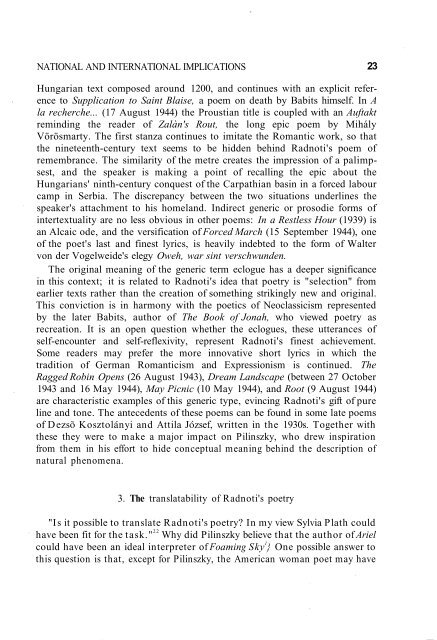HUNGARIAN STUDIES 11. No. 1. Nemzetközi Magyar ... - EPA
HUNGARIAN STUDIES 11. No. 1. Nemzetközi Magyar ... - EPA
HUNGARIAN STUDIES 11. No. 1. Nemzetközi Magyar ... - EPA
- No tags were found...
You also want an ePaper? Increase the reach of your titles
YUMPU automatically turns print PDFs into web optimized ePapers that Google loves.
NATIONAL AND INTERNATIONAL IMPLICATIONS 23Hungarian text composed around 1200, and continues with an explicit referenceto Supplication to Saint Blaise, a poem on death by Babits himself. In Ala recherche... (17 August 1944) the Proustian title is coupled with an Auftaktreminding the reader of Zalàn's Rout, the long epic poem by MihályVörösmarty. The first stanza continues to imitate the Romantic work, so thatthe nineteenth-century text seems to be hidden behind Radnoti's poem ofremembrance. The similarity of the metre creates the impression of a palimpsest,and the speaker is making a point of recalling the epic about theHungarians' ninth-century conquest of the Carpathian basin in a forced labourcamp in Serbia. The discrepancy between the two situations underlines thespeaker's attachment to his homeland. Indirect generic or prosodie forms ofintertextuality are no less obvious in other poems: In a Restless Hour (1939) isan Alcaic ode, and the versification of Forced March (15 September 1944), oneof the poet's last and finest lyrics, is heavily indebted to the form of Waltervon der Vogelweide's elegy Oweh, war sint verschwunden.The original meaning of the generic term eclogue has a deeper significancein this context; it is related to Radnoti's idea that poetry is "selection" fromearlier texts rather than the creation of something strikingly new and original.This conviction is in harmony with the poetics of Neoclassicism representedby the later Babits, author of The Book of Jonah, who viewed poetry asrecreation. It is an open question whether the eclogues, these utterances ofself-encounter and self-reflexivity, represent Radnoti's finest achievement.Some readers may prefer the more innovative short lyrics in which thetradition of German Romanticism and Expressionism is continued. TheRagged Robin Opens (26 August 1943), Dream Landscape (between 27 October1943 and 16 May 1944), May Picnic (10 May 1944), and Root (9 August 1944)are characteristic examples of this generic type, evincing Radnoti's gift of pureline and tone. The antecedents of these poems can be found in some late poemsof Dezső Kosztolányi and Attila József, written in the 1930s. Together withthese they were to make a major impact on Pilinszky, who drew inspirationfrom them in his effort to hide conceptual meaning behind the description ofnatural phenomena.3. The translatability of Radnoti's poetry"Is it possible to translate Radnoti's poetry? In my view Sylvia Plath couldhave been fit for the task." 22 Why did Pilinszky believe that the author of Arielcould have been an ideal interpreter of Foaming Sky 1 } One possible answer tothis question is that, except for Pilinszky, the American woman poet may have
















